Black Moor Goldfish is a fancy version of goldfish which was first bred in the early 1400s in China, so they have been around for a while now. This breed of goldfish has earned itself the nicknames Dragon Eyes, Moors, and Telescope Eyes because of their enlarged eyes that look similar to telescopes being one of their most distinctive traits.
One of the most popular fish in the world, the Black Moor Goldfish, is really peaceful and has a beautiful black velvet color. They can fit almost into any tank because of their relatively small size and are very easy to care for.
If you think these fish is perfect for you now, then just wait till you read more.
Overview
Everyone can keep these fish in their aquarium with almost no additional equipment. Both beginners and expert aquarium keepers should consider keeping it. Black Moor Goldfish is very adaptive to water conditions as it doesn’t need a water heater.
Black Moor Goldfish are not very good swimmers, so it’s better to have a long aquarium instead of a tall one to make it easy for them to reach the surface.
It also has bad eyesight, so having many decorations on your tank may prove to be an obstacle to these fish.
These fish can be fed a variety of standard foods, goldfish flakes being the most common one.
The only thing these fish cannot handle and may prove to be their undoing is the sudden temperature changes. Make sure to place your tank nowhere near other gadgets that radiate heat or near windows because of the sunlight.
Care details and specifications about Black Moor Goldfish:
| Care Level | Easy |
| Size | 4-8 Inch (10 -20 cm) |
| Lifespan | 10-15 years |
| Minimum tank size | 20 gallons (75 liters) |
| Diet | Omnivore |
| Temperature | 65-75° F (18 – 23° C) |
| pH | 6.5-7.5 |
| Hardness | 10-15 dkH |
| Temperament | Peaceful |
| Compatibility | Other peaceful community fish |
| Breeding | Medium |
| Swimming | All over the aquarium |
Origin & Habitat
Black Moor Goldfish are descendants of a species of wild carp known as the “Prussian Carp,” which originated in Asia.
A little history: Goldfish were first bred in China 1000 years ago. The development of these fish resulted in the 1400s with the Black Moor Goldfish, which was later traded in Japan, Europe, and America. Black Moor Goldfish is known to have many nicknames, but its scientific name is “Carassius auratus auratus”.
The term “Black Moor” is a reference to a group of people who inhabited North Africa.
Black Moor Goldfish cannot be found in the wild because they have been the product of selective captive-bred fish throughout the years. They can inhabit artificial stagnant, slow-moving waters of lakes and ponds.
Appearance & Typical Behavior
Black Moor Goldfish identify themselves with their enlarged telescope eyes protruding from each side of their head. It has an egg-shaped, stubby body and a long, flowing finnage which makes him not a good swimmer. Ironically even though its eyes are large, this fish has bad eyesight.
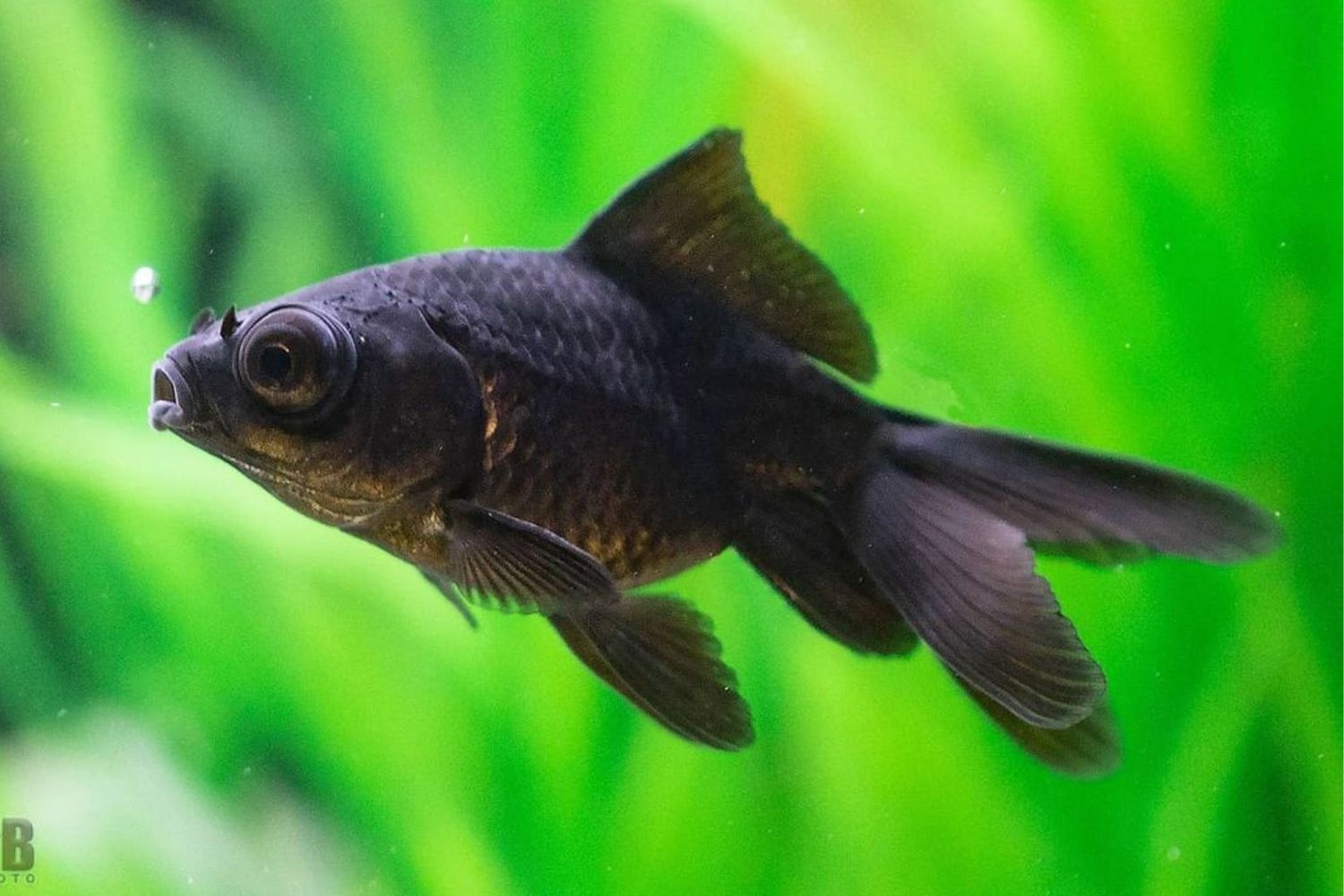
Black Moor Goldfish is also called “telescope fish” because of his eyes.
Black Moor Goldfish have bold deep black metallic scales, but only the high-quality ones have a velvety black color with no metallic scales. Their color may vary as they develop from a light gray to a darker black, though many of them develop from a rusted-color underbelly to orange splotches.
Black Moor Goldfish varies in size from 4 – 8 inches, and it’s a very hardy fish that can live between 10-15 years or more if they are kept well.
Black Moor Goldfish is a very peaceful community fish, it doesn’t get along well with boisterous fish, and it’s recommended to keep them alongside other peaceful species. Due to being a bad swimmer, it’s advised to keep him with species that share that similarity like other goldfish because it may find it hard to secure food if highly competitive fish are around.
Adding plants to your tank is a good idea as these fish likes to hide among them.
Food and Diet: What to Feed Your Black Moor Goldfish
Black Moor Goldfish is an omnivore species, so the key to feeding these fish is a well-balanced diet of plant and meaty food. You should limit the amount of protein gain to 30% of the diet so the fish can get the proper nutrients it needs. It’s hard to keep track of his protein every day.
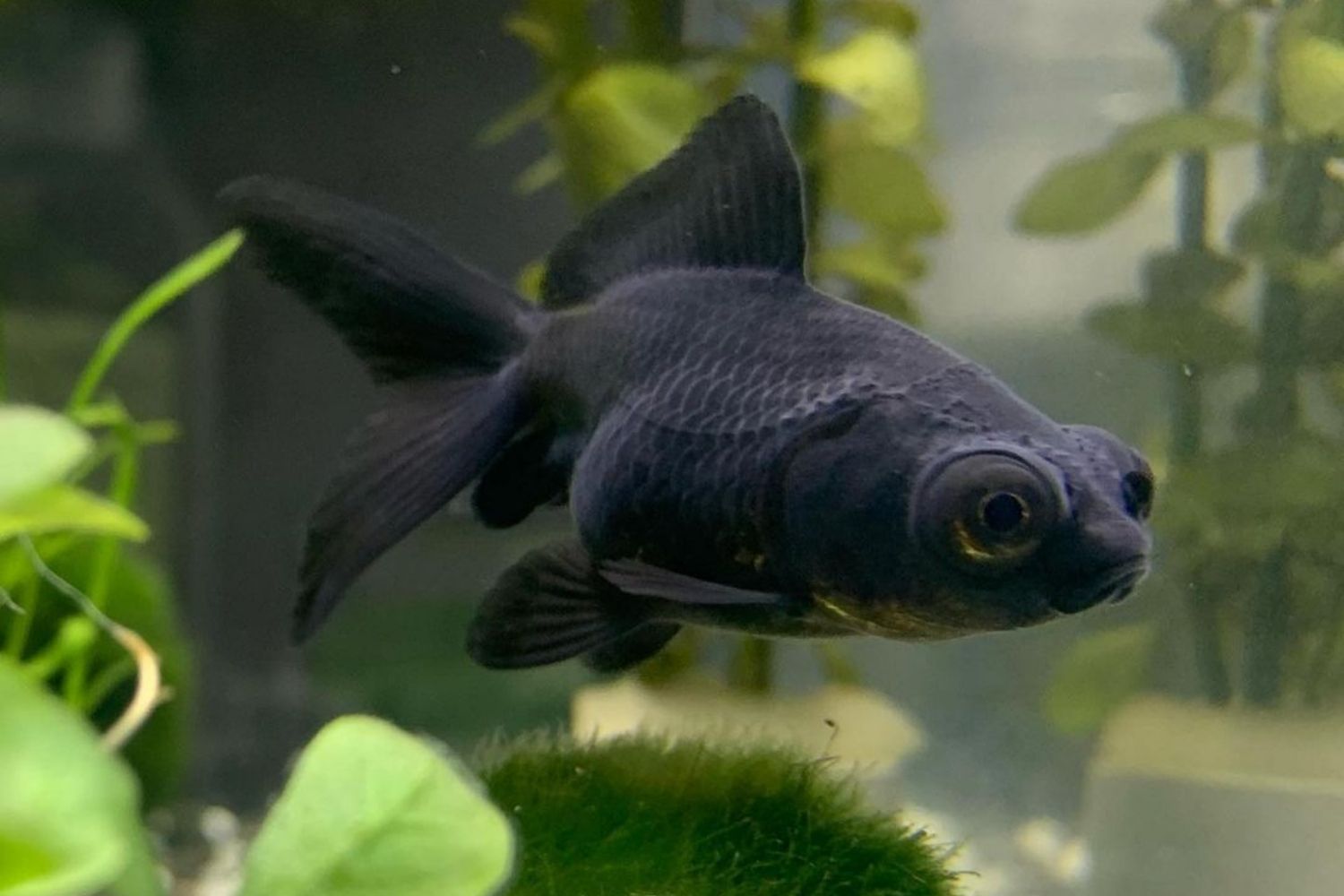
These fish grows very big, protein in his diet are essential.
Because Black Moors are omnivores, that means you can feed them a variety of frozen, dried, or live food. Some of the most common foods for these fish are listed below:
- Goldfish flakes & pellets
- Small insects
- Tadpoles
- Larvae
- Small pieces of green vegetation(algae)
- Daphnia
- Bloodworms
- Brine shrimp
- Green vegetables
Green vegetables are important to keep in check the digestive system because they contain fibers that lower the risk of constipation.
The most frequently used vegetables from other fishkeepers are lettuce, broccoli, and spinach.
Sometimes it’s better to presoak the food in the water tank before it’s given to the fish to make it easier for them to digest. It’s very important to keep a scheduled diet. You should feed your fish twice per day by only adding small amounts of food at a time.
Tank Requirements: How to Take Care of Black Moor Goldfish
Black Moor Goldfish is relatively easy to take care of. Even if you’re a beginner, you got nothing to worry about. Since these fish originates from carp in the waters of Asia, it’s recommended to accommodate the tank to those particular conditions.
Tank Size
Black Moor Goldfish require a tank size of 20-30 gallons (75 – 113 liters). If you intend to keep only one Black Moor, then a 10-gallon (37 liters) tank would suffice. If you add other fish alongside the Black Moor, then you should add 10 gallons per fish on the tank, so planning beforehand how many fish you are going to keep and taking into account their growth is very important to make a tank selection.
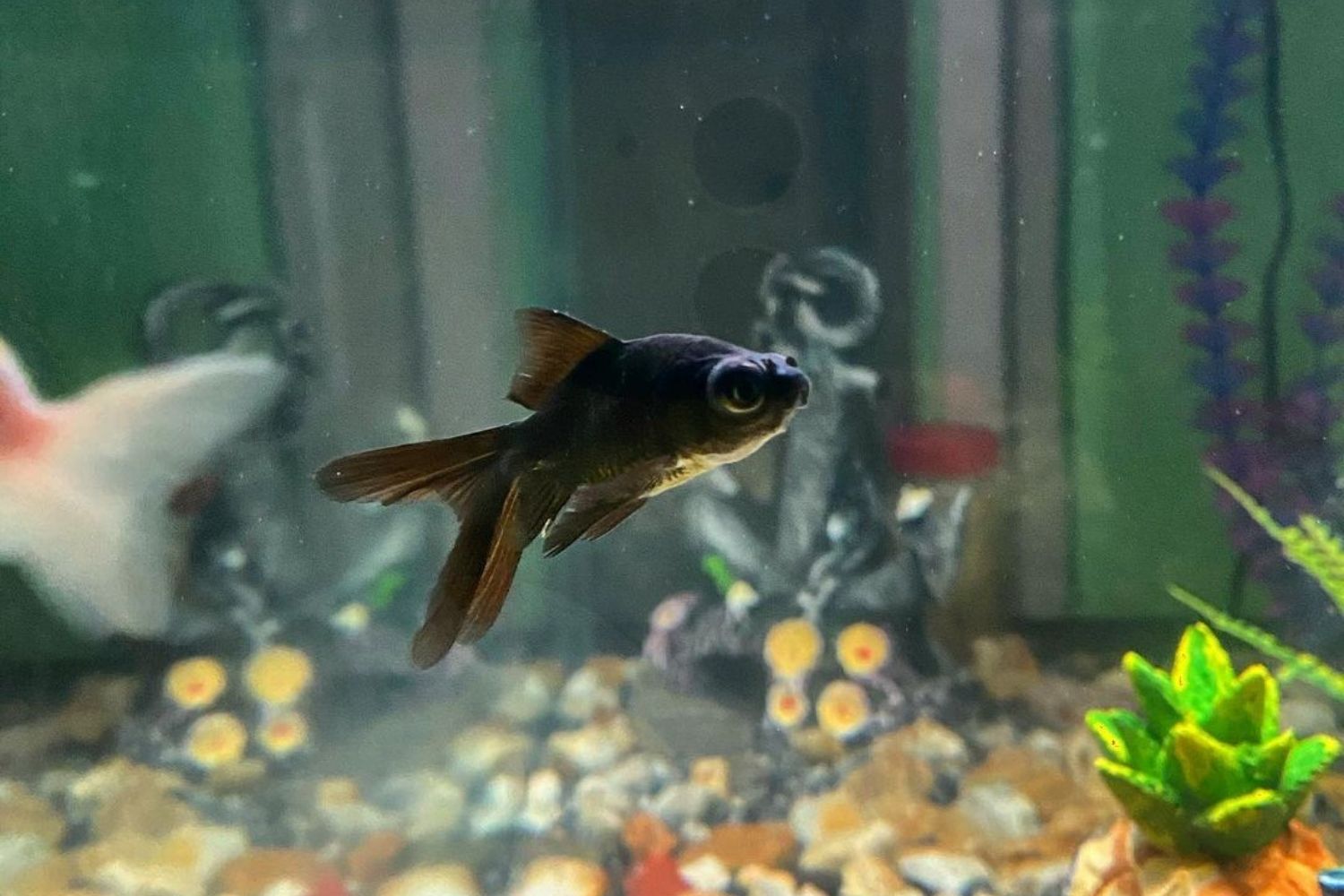
Black Moor Goldfish prefer aquariums with high water flow.
The larger the tank, the better because more amounts of water will result in less amount of waste and fewer water changes. A long tank would be the best choice for these fish because it provides a large surface area which minimizes the possibility of the fish suffering from an oxygen shortage.
The decoration of the tank should be smooth because of their poor eyesight, and it will hinder their orientation. Plants are a good choice. Live plants or artificial ones should be kept in the back of the tank to leave space in the center for the Moor to swim.
Black Moor Goldfish are diggers and may uproot live plants, so artificial ones may be the right choice. It’s your decision. Suggested live plants would be the ones that are common in areas with Asain Carp, like hornwort, which also helps to keep the tank clean. You can also go for silk plants. These fish might try to nibble at the plants from time to time.
The tank should have gravel or dirt lining at the bottom, rocks too, but not sharp ones because these fish will mess around and scatter them.
Water Temps & Parameters
Black Moor Goldfish are very hardy fish, and they can tolerate temperatures a few degrees above freezing as long as the temperature drops only a few degrees per day.
Sudden changes in temperature will prove to be fatal to these fish, and that is why you need to remember not to leave any source of heat near the aquarium. An aquarium heater is not required for these fish.
The best water parameters for these fish would be:
- 65-75° F
- KH 4-20
- pH 6.5-7.5
The water flow should be slow because, as mentioned earlier, Black Moors are bad swimmers.
Water changes should happen on a weekly basis, where you should remove 25-30% of the water tank and replace it with new distilled water. Water change is very important because these fish creates considerable amounts of waste, which may leave traces of ammonia in your tank that could harm or kill your fish.
Lighting
Lighting isn’t really necessary for these fish. Most aquariums come with a cover that includes lighting; if that’s your case, feel free to use it. The only benefit lighting would do is help these fish find their way around because of their poor eyesight, and of course it makes the aquarium a great showpiece to put on display.
Aquarium Filters for Black Moors
An aquarium filter is probably the only additional equipment you are going to need to maintain these fish. The filter is very important to disperse the ammonia in the water, wastes, and detritus and keep it clean.
It is recommended to get an aquarium filter that is meant for twice the size of the aquarium you possess.
Breeding: How to Set up a Spawning Tank
Black Moor Goldfish can only reproduce during the breeding season, which is in spring, so you will need to accommodate those conditions to the tank.
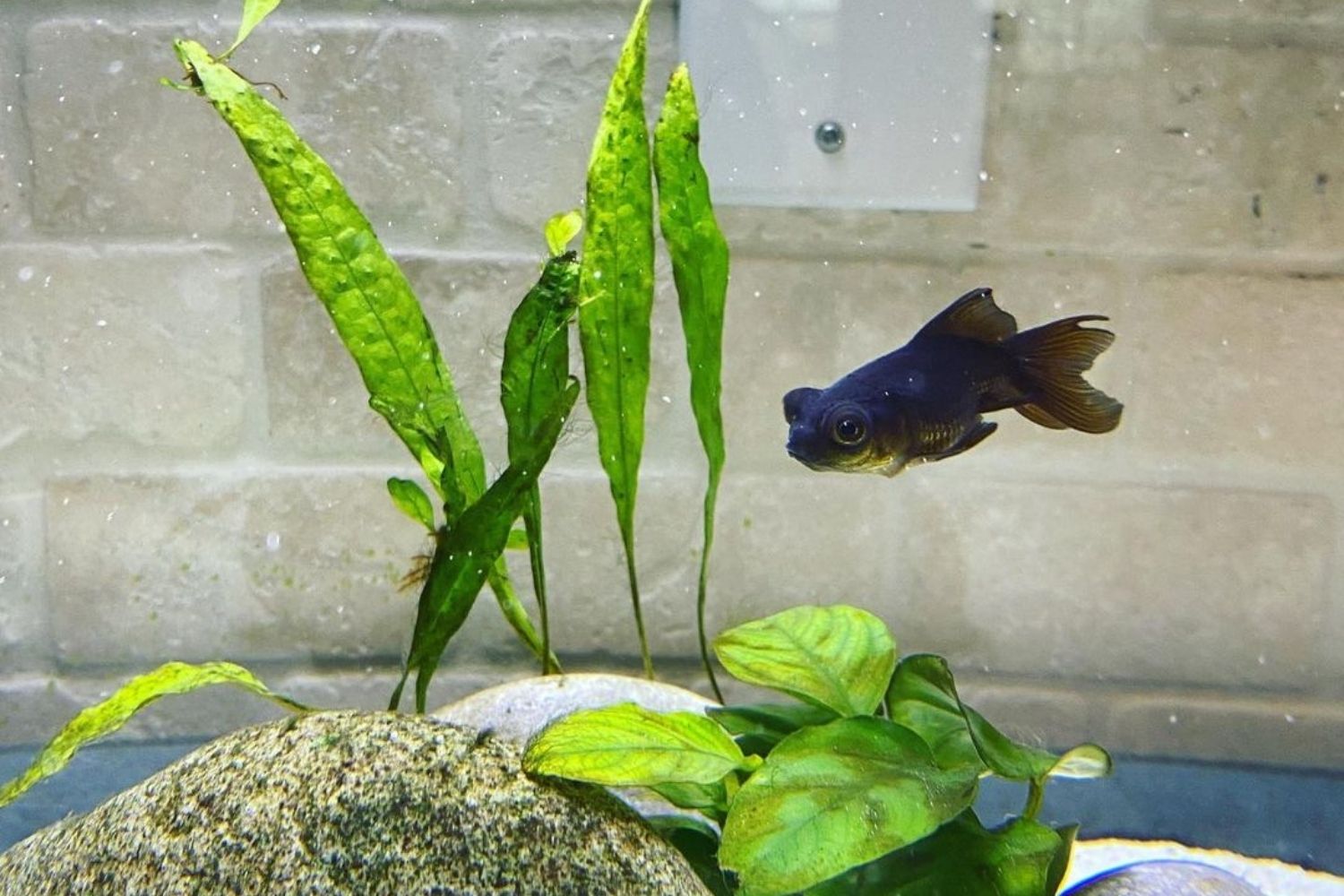
That’s how newborn Black Moor Goldfish looks like.
It’s recommended to keep males and females apart during the breeding season for them to gain interest in spawning. Both males and females are introduced to the breeding tank at the same. The breeding tank should have solid surfaces for the eggs to adhere to and oxygenate plants.
To finally commence breeding between them, you are going to slowly lower the temperature to around 60°F (15°C) and then gradually raise the temperature at a rate of 3°F (1°C) each day until the fish start breeding. Under no circumstances should you surpass 75°F (24°C). Feeding live food such as brine shrimp or live worms will help induce the spawning process, but always remember to feed at a small ratio.
The fish start breeding at around 68°-75° (20-24°C), and you should also change the water regularly at around 20% in the breeding tank to make sure the water is clean.
Black Moor Goldfish are egg layers, and as soon as the females lay their eggs, the males will fertilize them. The breeding process may take 2-3 hours, and they may even produce up to 10.000 eggs. After this, it’s extremely important to remove the parents from the breeding tank because they will start to eat the laid eggs.
The fertilized eggs will hatch in about one week, and you should feed them small fry food rich in irons until they are able to eat flakes or brine shrimp then you can introduce them to the same food as their parents.
The fry will have a dark brown color which will later turn into the adult’s color in several months, which is the right time to re-introduce them to the tank their parents are.
Sex: Sexual differences
You can differentiate males from females during the breeding season because males have white prickles called breeding tubercles. On the other side, the females will gain a fatter appearance because it is carrying eggs.
Black Moor Goldfish Diseases
Black Moor Goldfish, if cared for properly and maintained under the designated parameters, won’t catch any sort of disease.
In case that happens, here are some of the most common Black Moor Goldfish diseases:
Protozoan Disease:
- Ich – Also known as White Spots Disease, ich is a very common disease to freshwater fish and can be treated, but if left for too long may prove fatal.
- Costia – A disease that causes cloudiness of the skin.
- Chillodonela – Causes blue cloudiness on the skin
External Parasite Disease:
- Flukes – which are flatworms that infest the gills or body of the fish, can easily be treated but are dangerous if left uncared.
- Fish lice – They are crustaceans that attach themselves to the body of the fish.
Bacterial Diseases:
- Dropsy – an infection on the kidneys that can be proven fatal.
- Fish tuberculosis – You can tell your fish have this disease because of its hollow belly, and in this case, there is no treatment and will prove fatal to your fish.
Swim Bladder Disease: A disease that you can point out by observing your fish. It will swim in abnormal patterns and have difficulty keeping its balance. The causes of this disease are poor nutrition, constipation, physical deformity, or an infection.
If and when your fish shows signs of any of these diseases, you need to remove it from the tank and go to the proper veterinarian to get the appropriate treatment. You should also remove the other fish from the tank until you clean the tank of all harmful properties.
Tank Mates
Black Moor Goldfish is a community fish that can lie together with any other fish as long as they share their discrepancies. A highly competitive fish will be bad for Black Moors because they are bad swimmers and may get harassed or left without food because they can’t compete.
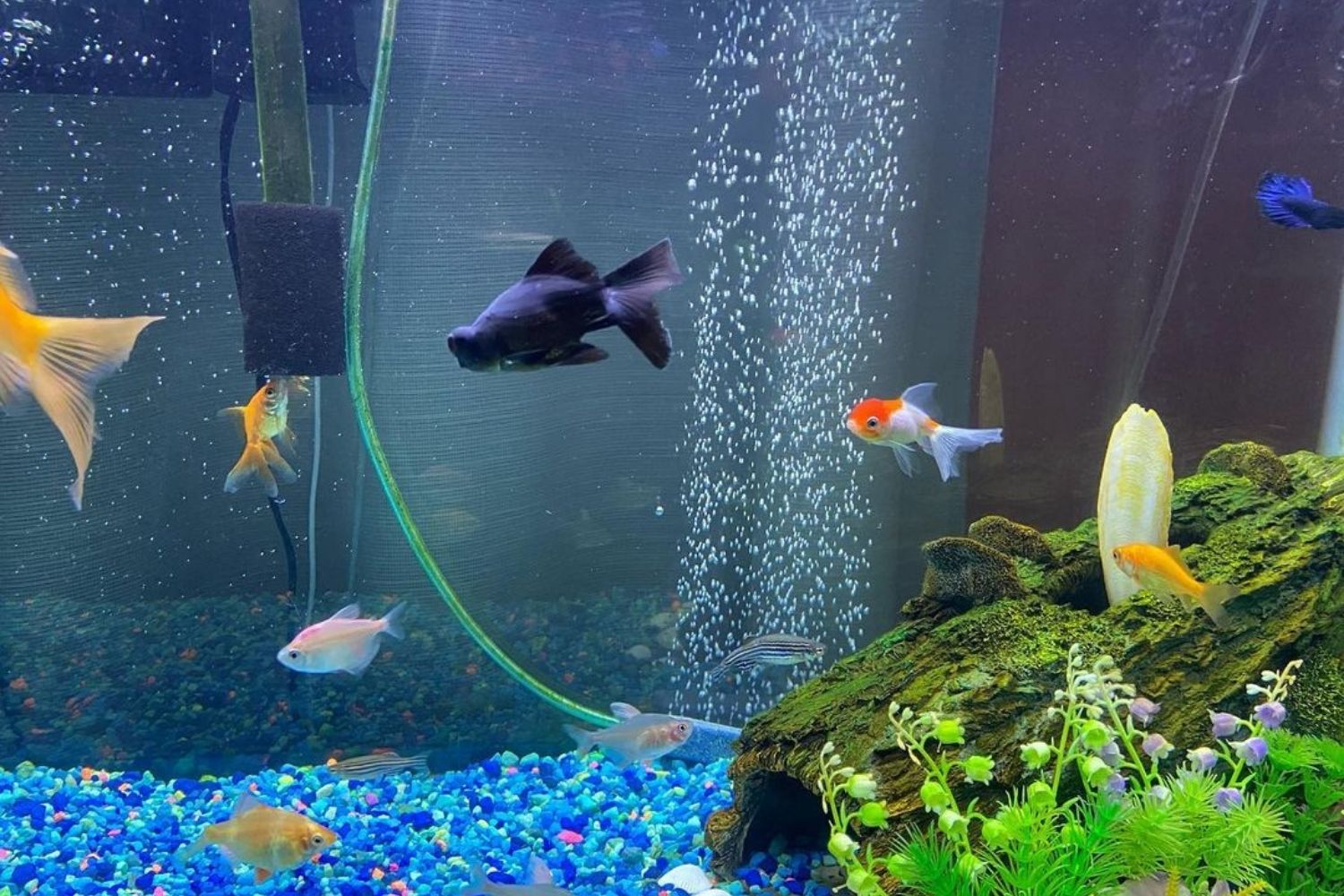
Black Moor Goldfish with other Goldfishes, that’s how we keep it on our aquarium.
Some of the most common tank mates for Black Moors are:
- Other variety of Fancy Goldfish
- Angelfish
- Mollies
- Neon Tetras
- Panda Garra
- Odessa Barb
- Glass Catfish
Small invertebrate species such as snails or shrimp are also a nice addition to the tank, such as Mistery Snails, Ghost Shrimp, Amano Shrimp.
Conclusion
Black Moor Goldfish is one of the most special varieties of fancy goldfish that would make a great addition to your tank. Being a community fish will create a peaceful environment inside your tank. If you like its velvety black color and the fact that is easy to take care of, then this fish is the right one for you.

Black Moor Goldfish brings a nice look to your aquarium.

